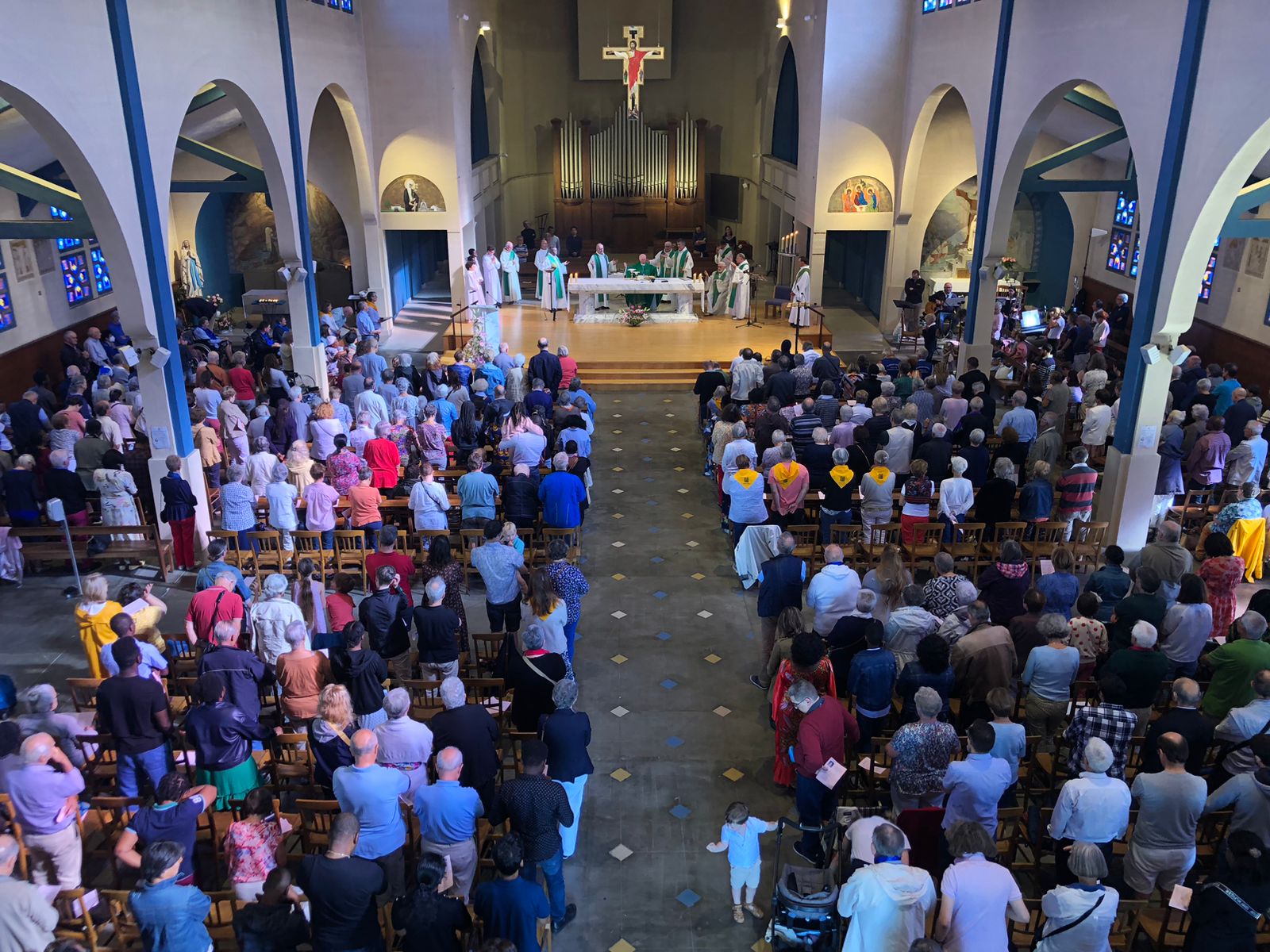
Welcome to Notre-Dame de Lourdes church, part of Sainte Catherine du Petit Port parish. You have entered this church and as you read these lines you will be able to discover some of its history.
The church as we see it today dates from the first half of the 20th century. It was completed in 1950. It was designed by Yves Liberge, an architect from Nantes who also designed the buildings on Calvaire St in Nantes. Originally, however, there was a small church, the story of which follows.
In 1882, five property owners from Nantes and Orvault (Joseph Vincent, Charles Pellerin, Louis Fortun, François Lechat and Alexis Jobart) applied to the bishop for an emergency chapel to be built on the Pont du Cens. The main argument was, of course, the distance separating the Pont du Cens from the churches of Saint-Félix and Saint-Similien, which was uncomfortable for the population. The two Nantes parishes concerned, as well as those of Saint-Herblain and Orvault, reacted negatively to this request, which cut into their parishes and their revenues. Despite this, in May 1882, the five promoters bought the « Decrais holding » at the bottom of the hill for 25,000 francs. They then launched a subscription campaign, which brought in substantial sums, which seemed sufficient to build a chapel.
After appealing to the bishop and the Nantes town hall, and then being reassured by the bishop that he was in agreement, they began work in March 1885. The estimated cost was 25000 francs, but the work ended up costing 33,000 francs, mainly because of the deeper foundations required. Permission for the chapel opening was granted by episcopal tolerance, but only as a private chapel, and the Saint-Félix parish priest was delegated the necessary authority to bless the chapel, statues and objects of worship. On 21 November 1886, the chapel opened its doors to the faithful for the first time.
In 1890, a sacristy was built and work continued on the interior of the chapel: a subscription enabled the purchase of statues and the stations of the Cross. The altar came from the former church of Saint-Similien. By 1892, the chapel was already home to 200 to 300 parishioners and had a presbytery. In 1893, a girls’ school was founded near the chapel, run by the Sisters of Saint-Philibert. Catechism classes began in the chapel in October 1893, and the first children from Pont du Cens to receive catechism classes at Notre-Dame de Lourdes took communion at Saint-Félix in 1895. The vocation of Notre-Dame de Lourdes was canonically established in 1896. The parish did not officially come into being until 25 April 1926, by episcopal letter.
The first parish priest was Father Poupard, from 20 May 1926. The old chapel soon proved to be inadequate, and plans for a new church were drawn up in 1931, under the direction of architect Liberge. Work began on the choir. In November 1931, the old chapel was demolished to allow work on the church to continue. On 31 January 1937, a new church was ready to welcome the faithful, but due to a lack of funds, it was stripped of one bay, its façade and the bell tower. Nevertheless, it was blessed the same day by Bishop Villepelet. The Second World War prevented work from continuing, and the temporary façade was damaged by the cyclone of March 1951. Work was not resumed until 1957, when a façade was added to the original plans, symbolizing the grotto at Lourdes containing the statue of Virgin Mary.
In the 1970s, the sale of part of the grotto site enabled the interior of the church to be repainted in cream color. Father Gabriel Alain, the parish priest, installed curtains, a sound barrier at the back of the church and picture rails to reduce the echo in the church.
Due to a decline in religious practice, the parishes of Saint Dominique, Saint François d’Assise and Notre Dame de Lourdes joined forces to form a new parish in 2005, named Sainte Catherine du Petit Port, in memory of a convent dedicated to Saint Catherine of Siena that existed on Route de la Chapelle in the Middle Ages. In 2020, a large-scale replica of the Tibhirine cross, created by Breton artist Kerozen, was installed in the church. The cross was chosen in memory of Blessed Célestin Ringeard, a priest who worked in La Boissière district for around twenty years before becoming a monk at the Tibhirine monastery. He was one of the monks murdered by fanatics in 1996. Kerozen also created the two other paintings on either side of the altar, one depicting Roubiev’s famous icon of the Trinity, and the other depicting an icon of Saint Catherine of Siena, with the parish’s three churches behind her.
![]()
Enjoy your visit and see you soon.
